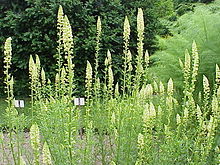Resedaceae
| Resedaceae | |
|---|---|

| |
| Reseda lutea (Wild mignonette) | |
| Scientific classification | |
| Kingdom: | Plantae |
| Clade: | Tracheophytes |
| Clade: | Angiosperms |
| Clade: | Eudicots |
| Clade: | Rosids |
| Order: | Brassicales |
| Family: | Resedaceae Martinov |
| Genera | |
|
See text | |
Resedaceae is a family of mostly herbaceous dicotyledonous plants comprising 107 known species in 8 to 12 genera:[1]
- Borthwickia - 1 species, sometimes placed in its own family Borthwickiaceae
- Caylusea - 3 species
- Forchhammeria - 10 species
- Homalodiscus - 2 species
- Neothorelia - 1 species
- Ochradenus - 4 species
- Oligomeris - 3 species
- Randonia - 1 species
- Reseda - ca 55 species
- Sesamoides - 1 species
- Stixis - 7 species
- Tirania 1 species
Taxonomy
Roman natural philosopher Gaius Plinius Secundus or Pliny the Elder, who lived in the first century, is attributed to have used the name Reseda for the first time in writing. But he must have used it for another plant, because the medical effect of healing swellings and inflammations that he described, could not be reproduced from Reseda by later researcher. The British botanist Samuel Frederick Gray erected the family Resedaceae in 1821, based on the type genus Reseda as validly described by Carl Linnaeus.[2]
Recent molecular studies suggest that Oligomeris, Randonia and Ochradenus all arose from within the ranks of Reseda. This would imply that only three genera should be recognized, although as yet no nomenclatural changes have been made.[3]
The family includes annuals, biennials and perennials and is distributed in temperate to sub-tropical regions of Europe, western Asia, the Middle East, East Asia, North America, Mesoamerica, the Caribbean and South Africa.
Resedaceae were placed under the Cronquist system in the order Capparales. The APG II system places it in the order Brassicales. In APG IV (2016)[4] it was expanded to include the genera Borthwickia (formerly Borthwickiaceae), Neothorelia, Stixis, and Tirania (formerly Stixidaceae) and Forchhammeria (formerly in Capparaceae)
References
- ^ Christenhusz, M. J. M. & Byng, J. W. (2016). "The number of known plants species in the world and its annual increase". Phytotaxa. 261 (3): 201–217. doi:10.11646/phytotaxa.261.3.1.
- ^ Abdallah, M.S. (7 July 1967). The Recedaceae - A taxinomical revision of the family (MSc). Veenman & Zonen, Wageningen NL. Retrieved 7 July 2022.
- ^ Santiago Martín-Bravo; Harald Meimberg; Modesto Luceño; Wolfgang Märkl; Virginia Valcárcel; Christian Bräuchler; Pablo Vargas & Günther Heubl (2007). "Molecular systematics and biogeography of Resedaceae based on ITS and trnL-F sequences". Molecular Phylogenetics and Evolution. 44 (3): 1105–1120. doi:10.1016/j.ympev.2006.12.016. PMID 17300965.
- ^ Angiosperm Phylogeny Group (2016), "An update of the Angiosperm Phylogeny Group classification for the orders and families of flowering plants: APG IV", Botanical Journal of the Linnean Society, 161 (2): 105–20, doi:10.1111/boj.12385
